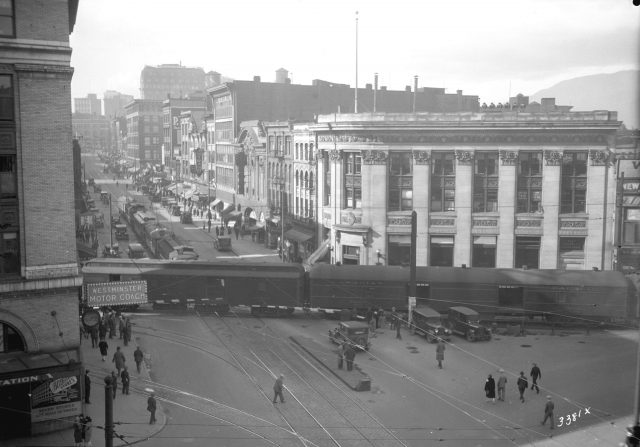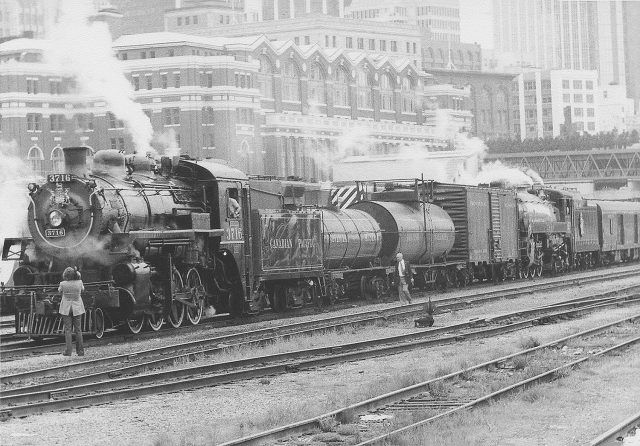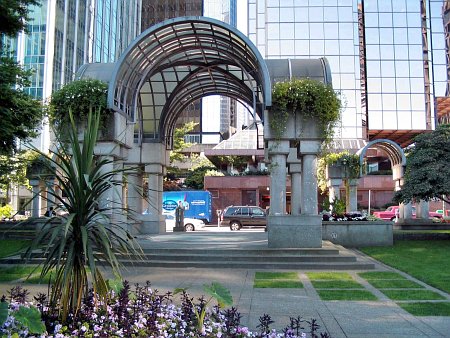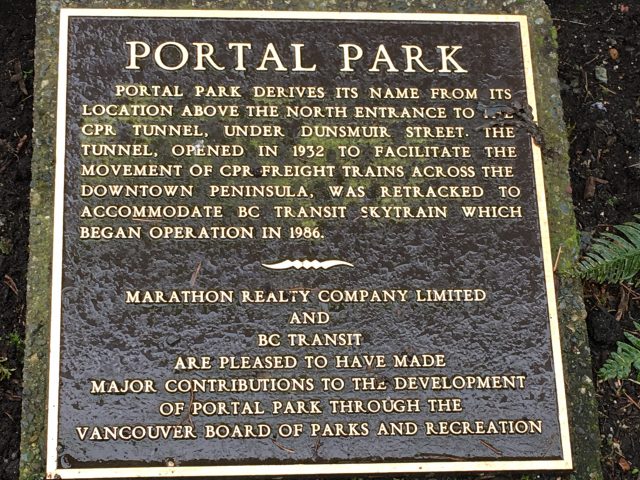The Dunsmuir Tunnel opened in July 1932. It started at Waterfront Station, passed under Thurlow, crossed to Burrard and came out by the Georgia Viaduct.
While you’re stuck for an hour on the Lions Gate Bridge or crawling through the George Massey Tunnel, it may be comforting to know that traffic problems, just like the price of real estate, have always been an issue in Vancouver.
Story from Vancouver Exposed: Searching for the City’s Hidden History

The crossing:
As early as 1914, there were calls for an end to the Carrall and Hastings Street crossing, where freight and passenger trains could hold up traffic for up to an hour a day getting from the CPR yards on Burrard Inlet to the yards at False Creek.
The crossing was still there in 1929 when a Vancouver Sun editorial called it an obstacle to the growth of Vancouver. “It costs Vancouver people thousands of dollars. It depreciates real estate values in the neighborhood to the extent of hundreds of thousands of dollars.”

The tunnel:
The Dunsmuir Tunnel finally opened in July 1932. The new tunnel was 1,400 metres (4,600 feet) long and lined throughout with concrete. Steam engines now followed a 190-degree arc from Waterfront Station, passing under Thurlow, crossing to Burrard and then going under Dunsmuir to Cambie where the tunnel cut under the old bus depot at Larwill Park and came out by the Georgia Viaduct.
Andy Cassidy worked for the CPR at the Drake Street roundhouse until it closed in 1981. “I travelled through that tunnel daily for years either on the passenger cars going from the station to the coach yard, or later on while taking the locomotives from the shop over to the waiting train at the station,” he told me. “I used to have to adjust the locomotive headlights regularly on the way through.”

Last train:
The last train went through the tunnel in August 1982. The tunnel then went under a $10 million renovation and was repurposed as SkyTrain’s Expo line, with the westbound track now stacked above the eastbound track. The new tunnel, with the Burrard and Granville Street stations built inside, opened in time for Expo 86.

The eastern entrance to the tunnel was a concrete art deco portal set into the base of the cliff below Beatty Street. It was demolished to make way for the Cosmo, a 27-storey tower that opened in 2012. The western end of the tunnel is under Portal Park at West Hastings and Thurlow Streets—a City of Vancouver park built on a concrete roof in June 1986.

Related:
- The Dupont Street train station
- Thornton Tunnel and the fake house
- The train that ran down hastings street
© All rights reserved. Unless otherwise indicated, all blog content copyright Eve Lazarus.




6 comments on “The Dunsmuir Tunnel”
Thanks for more great memories. As a young teenager, around 1970, we used to ride our bikes all over the area and “discovered” the little used tunnel. Only the bravest would venture too far inside. After a slight curve there was nothing but complete darkness inside and a hasty retreat was the only reasonable thing to do.
Yeah I remember walking through the Dunsmuir Tunnel as a teenager in the summer of 1981 after railway operations ceased. No flashlight. Just bounced between the two rails in total pitch darkness for 20 minutes! Now I truly know what is the meaning of “the light at the end of the tunnel”!!!
It was a Sunday afternoon in 1976 when a group of five us decided to walk the full length of the tunnel. We reasoned that there would be little rail traffic on that day. We walked past the No Trespassing signs and entered the tunnel from the harbour end. There were only two flashlights in use, and they did little to dispel the pitch dark after the first curve. We knew that there were refuge alcoves in the tunnel walls. Every so often we could hear sounds of harbour activity coming into the tunnel.
After about twenty minutes, we heard the sound of a locomotive entering the tunnel behind us. We immediately headed to the alcoves, and waited. The engine noise increased more and more until we thought the train was going at a high speed, but when it arrived it was travelling much slower. There was light from the locomotive, so we were able to see the train. It took only a few minutes for the train to pass, and we resumed our walk. Since we could not see the end of the tunnel due to the curve at the False Creek portal, it was still very dark and the flashlights were dimming. Each time we heard a locomotive sound we ran for cover, but it was just shunting in the yards. It was a great relief when we finally saw the light at the end of the tunnel and emerged at the CPR False Creek Yards.
The harbour waterfront was wide open in the 1970s, and on a Sunday afternoon it was ideal for a bike ride, as mentioned by Peter. You could ride from Cardero Street to Victoria Drive, and cycle out to the ends of most of the piers, where men were fishing.
Great memories and story Eve! Growing up in North Vancouver, it was a big deal going downtown to that area unless you had a purpose. We have quite the train system over here, which transports quite a bit of goods annually.
Bob Kerr. The empty grain cars used to sit on the tracks by the Immigration Bldg. The area was full of pigeons messing the surrounding area so was it true that one solution was to seal up the empty cars full of pigeons send them through the Dunsmour Tunnel to where they would stop next to China Town and everyone had plenty of Pigeon pot Pie. This was halted when the cars didn’t stop there for a clean out but somehow were routed to Calgary and all hell broke out. Or was this just a rumour? My Grandfather came to Vancouver in 1884 but went to Naniamo first as it was booming with the coal industry. Vancouver has sure changed in my 93 years living here & practicing as an Architect. As the designer of the Aquarium in Stanley Park things have sure changed during my brief life here. Keep up your your good work. Bob Kerr
It was the last day of school in ’55 or ’56. Two friends and I were walking towards home after Army Cadets at The Drill Hall on Beatty. We got the brilliant idea of finding out where the tunnel went, so decided to walk through it. Didn’t think about trains, of course; in our 14-year old complacence, if we didn’t know about the tunnel, how would trains know? After stumbling down the tunnel for what seemed like an hour, bouncing off the walls and tripping on the rails and ties, we hear A TRAIN coming! Abput that time, the light was starting to show from one of the pull-outs, and we managed to make it in there just in time to be missed by the thing. As it took its time rolling by, we got ready, and when it cleared, ran along behind it in the dim light from its tail light (whatever) untli it got away from us. We made it to within sight of the next waypoint just in time for the second train to chase us, panicking, getting in there just in time.
Rinse and repeat. Don’t remember how many of these we did, but it seemed like a dozen. I was never so glad to see the waterfront! Needless to say, we elected not to do a return trip by tunnel! Quite an adventure! Too soon old and too late smart!